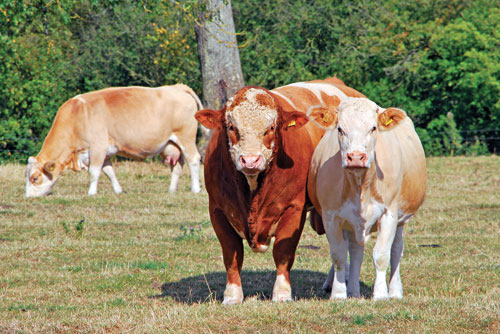It’s hard to get a handle on how extensive cattle theft has become. Few states keep statistics; in some cases, though, private organizations do. The Texas & Southwest Cattle Raisers Association (TSCRA) says 7,400 head were reported stolen in 2009, up from 6,400 the year before; a website maintained by Bayer Animal Health claims in Missouri in 2008, there were $500,000 worth of cattle stolen across 29 counties.
Jeff Windett is executive director of the Missouri Cattlemen’s Association, which for the last 5 years has been part of a farm and livestock protection task force that includes other farm groups, the Missouri Department of Agriculture, the Highway Patrol and county Sheriffs’ Departments. “We’ve got a cattle theft hotline, 888-484-8477,” he told Ozarks Farm & Neighbor. “If there’s a cattle theft reported, the first order of business for a producer is to call the Sheriff’s Department and file a police report. They, in turn, file that information with the Missouri Information Analysis Center; they maintain a database.” Investigators can compare the description of the vehicle and details of the crime with similar incidents elsewhere in the state and detect trends.
Most of this data is compiled from local news reports, but the TSCRA also hires “Special Rangers” who work with law enforcement agencies in Texas and Oklahoma. One of them collaborated with a sheriff’s office in Oklahoma on an investigation that led to the September arrest of an Edmond, Ark., man who is suspected in several thefts. In July, a Leslie, Ark. man was charged with stealing 81 head of cattle over seven separate occasions; he was apprehended when he attempted to sell the cattle at a local stockyard, and suspicious employees alerted the authorities.
Johnson County, Ark. Sheriff Jimmy Dorney told OFN. he’d handled two cases of suspected cattle theft in the last 4 years; the most recent, this past August, involved three young men from another county, two of them still in high school. “I guess, in short, they needed money,” Sheriff Dorney said. “Working part time at a livestock auction house, they knew how to get some quick money pretty easily, so they came into our county and found nine Charolais crossbred calves that were in a corral. They took them to the livestock auction where one of them actually worked and sold them.”
Not so forthcoming was the alleged perpetrator in the other case, in 2006; he went to a jury trial and was sentenced to 15 years at the Department of Corrections and a $10,000 fine, plus restitution. He had been charged with stealing five cattle and transporting them all the way to the other side of Arkansas to be sold; once again, calls to sale barns turned up the missing animals. “The sale barns have been good in both of these cases to work with,” the sheriff noted.
Although there have been few cases reported in Johnson County, Ark., Sheriff Dorney said sheriffs in other counties indicate cattle theft is becoming more common; he suspected that’s a result of a bad economy and relatively high priced cows.
Although padlocking gates can be one way to keep trespassers out, Dorney pointed out the defendant in the 2006 case was thought to have cut the lock. The best deterrent to theft, he believes, is a mutual network of eyes and ears, adding farmers keep unusual hours. “In the rural communities like that,” he said, “I found, back when I was on patrol, there’s always someone out moving, just checking on their farm or crops in the early morning. Just keep an open eye out on your neighbor’s farm and their possessions, as well as your own,” he concluded.
Jeff says through 2009, the task force had fielded reports on $1.3 million worth of cattle and property theft. MCA also prevailed on the state legislature to boost cattle theft to a Class B felony, punishable by 5 to 15 years incarceration; Jeff said, “I think that’s been a pretty good deterrent.”
Travis Justice, senior economist for Arkansas Farm Bureau and administrator of the state beef checkoff program, told OFN that Farm Bureau has a reward program for information leading to arrest and conviction for property theft, but said he hasn’t seen a big increase in payouts. Still, he said, “It makes sense as the value of animals go up, as we’re seeing now, incidents of theft may go up with it.”
Beyond monitoring animals it’s helpful to use forms of identification, like tags or electronic chips. In the old days the ranchers could identify their property via branding, but that method has fallen out of favor; it reduces the value of the hide.
And most thieves, it appears, at least know enough not to market the cattle in their victim’s backyard. “The last two instances,” said Sheriff Dorney, “we’ve had to go at least two counties away to find the cattle, and that’s what’s unique to me about a cattle farmer; they can walk out and look over a herd of 150 cows and if they’ve had five stolen, they can immediately pick their five out of a herd. I could never do that, but the farmers know what they’re looking for.”




